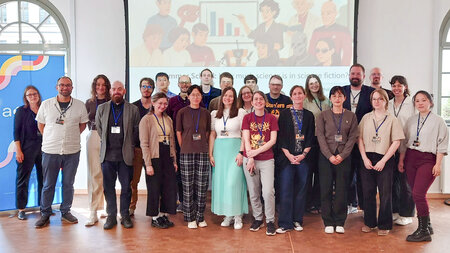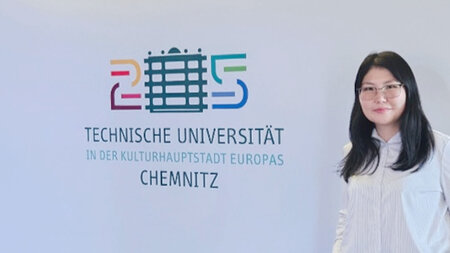Chemnitz Research Results Honored as Cover Story
Chemnitz University of Technology research team clarifies the role of amino acids in the binding of biocompatible bismuth oxido nanoclusters to gold – The experimental results were published in the journal “Langmuir” and highlighted on the “Supplementary Cover”
-

Successful jump to the cover picture: The connection of atomically precise chiral bismuth oxido nanoclusters to gold is shown. The gold surface of the cover image was created with the help of artificial intelligence. Graphic: TU Chemnitz/Langmuir
Electrons and many atomic nuclei carry not only an electric charge but also a magnetic moment, known as "spin" or intrinsic angular momentum. It is widely assumed in the scientific community that the controlled generation of a transient spin order of electrons or magnetic nuclei, referred to as hyperpolarization, in molecular systems has significant implications for various fields of physics and chemistry, such as spintronics – electronics that can also be controlled by magnetic fields. New approaches in hybrid organic/inorganic spintronics utilize an effect caused by chiral molecules, known as chiral-induced spin selectivity (CISS). Previous studies on this topic have mainly focused on helical molecules, which, due to their inherently chiral structure, result in different current intensities depending on the magnetic field direction.
At Chemnitz University of Technology, an interdisciplinary research team, consisting of the MAIN research group Magneto-Optics (headed by Prof. Dr. Georgeta Salvan) and the chairs for Semiconductor Physics (headed by Prof. Dr. Dietrich R.T. Zahn), Coordination Chemistry (headed by Prof. Dr. Michael Mehring), and Analytics at Solid State Surfaces (headed by Prof. Dr. Christoph Tegenkamp), investigated the attachment of atomically precise chiral bismuth oxido nanoclusters to gold. The study sheds light on the relationship between the chemical structure of the nanometer-sized clusters and their attachment to the gold substrate, with the next step being to determine the physical factors influencing the CISS effect. The successful chemical attachment of the clusters to surfaces is the crucial step for effective spin transport from the molecule to the substrate and was successfully demonstrated using spectroscopic ellipsometry and X-ray photoemission spectroscopy. The results were published in July 2024 in the renowned journal "ACS Langmuir" and were prominently featured on the "Supplementary Cover."
Future experiments will focus not only on the direct investigation of the spintronic properties of these spherical molecules, which resemble quantum dots, but also on the targeted polarization of light-excited electrons in a complex arrangement of clusters as light absorbers and helical molecules. This promising research approach is part of the SFB-Transregio TRR-386 HYP*MOL – Hyperpolarization in Molecular Systems, which uniquely combines research questions related to magnetic resonance, spintronics, and spin chemistry.
Publication: Annika Morgenstern, Rico Thomas, Oleksandr Selyshchev, Marcus Weber, Christoph Tegenkamp, Dietrich R. T. Zahn, Michael Mehring*, Georgeta Salvan*. Anchoring Atomically Precise Chiral Bismuth Oxido Nanoclusters on Gold: The Role of Amino Acid Linkers, Langmuir 2024, 40, 31, 16320–16329, https://pubs.acs.org/doi/10.1021/acs.langmuir.4c01445
For further information please contact Prof. Dr. Georgeta Salvan, Telephon +49(0)371 531-33137, email salvan@physik.tu-chemnitz.de, and Prof. Dr. Michael Mehring, Telephon +49(0)371 531- 21250, email michael.mehring@chemie.tu-chemnitz.de.
(Authors: Annika Morgenstern and Rico Thomas)
Mario Steinebach
06.09.2024




